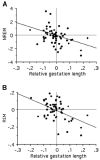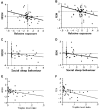Phylogenetic analysis of the ecology and evolution of mammalian sleep
- PMID: 18384657
- PMCID: PMC2674385
- DOI: 10.1111/j.1558-5646.2008.00392.x
Phylogenetic analysis of the ecology and evolution of mammalian sleep
Abstract
The amount of time asleep varies greatly in mammals, from 3 h in the donkey to 20 h in the armadillo. Previous comparative studies have suggested several functional explanations for interspecific variation in both the total time spent asleep and in rapid-eye movement (REM) or "quiet" (non-REM) sleep. In support of specific functional benefits of sleep, these studies reported correlations between time in specific sleep states (NREM or REM) and brain size, metabolic rate, and developmental variables. Here we show that estimates of sleep duration are significantly influenced by the laboratory conditions under which data are collected and that, when analyses are limited to data collected under more standardized procedures, traditional functional explanations for interspecific variation in sleep durations are no longer supported. Specifically, we find that basal metabolic rate correlates negatively rather than positively with sleep quotas, and that neither adult nor neonatal brain mass correlates positively with REM or NREM sleep times. These results contradict hypotheses that invoke energy conservation, cognition, and development as drivers of sleep variation. Instead, the negative correlations of both sleep states with basal metabolic rate and diet are consistent with trade-offs between sleep and foraging time. In terms of predation risk, both REM and NREM sleep quotas are reduced when animals sleep in more exposed sites, whereas species that sleep socially sleep less. Together with the fact that REM and NREM sleep quotas correlate strongly with each other, these results suggest that variation in sleep primarily reflects ecological constraints acting on total sleep time, rather than the independent responses of each sleep state to specific selection pressures. We propose that, within this ecological framework, interspecific variation in sleep duration might be compensated by variation in the physiological intensity of sleep.
Figures





References
-
- Affani JM, Cervino CO, Marcos HJA. Absence of penile erections during paradoxical sleep. Peculiar penile events during wake-fulness and slow wave sleep in the armadillo. J Sleep Res. 2001;10:219–228. - PubMed
-
- Allison T, Cicchetti DV. Sleep in mammals: ecological and constitutional correlates. Science. 1976;194:732–734. - PubMed
-
- Ambrosini MV, Giuditta A. Learning and sleep: the sequential hypothesis. Sleep Med Rev. 2001;5:477–490. - PubMed
-
- Bejamini Y, Hochberg Y. Controlling the false discovery rate: a practical and powerful approach to multiple testing. J R Statist Soc B. 1995;57:289–300.
-
- Benington JH, Heller HC. Does the function of REM sleep concern non-REM sleep or waking? Progress Neurobiol. 1994;44:433–339. - PubMed
